About Scottish Fold Cats
Scottish Fold cats are a pretty special breed in many ways.
They get their name from the unique way their ears are folded forward.
The long-haired variety is known as the 'Coupari' in Canada and the 'Highland Fold' elsewhere.
Meanwhile in Australia, the straight-ear variety is recognized as a separate breed, and know as the 'Scottish Shorthair'.
All Scottish Folds can trace their genetic lineage back to one specific ancestor who lived in Scotland during the mid 20th century!
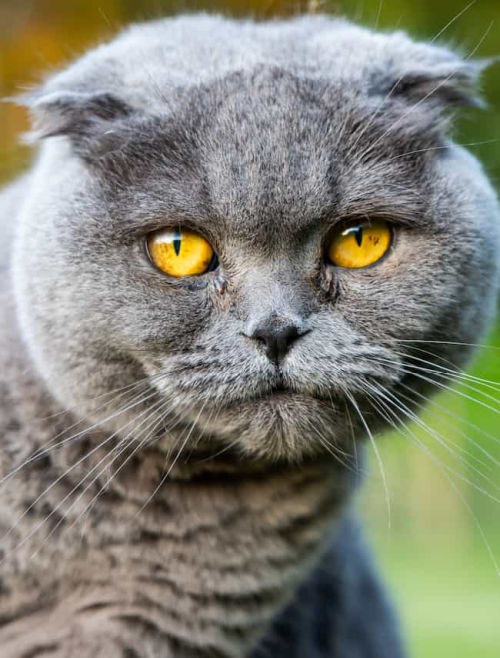
History of Scottish Fold Cats
The first Scottish Fold was a white cat called Susie, who lived on a farm near Coupar Angus in the Tayside area of Scotland in the 1960's.
Susie had the 'folded ears' that are so distinctive and well-recognized in the breed today, but were unique at that time.
Susie had a litter of kittens, two of them had folded ears and a neighboring farmer William Ross, and his wife Mary, fell in love with one of them.
She was a little white female whom they adopted and called 'Snooks'.
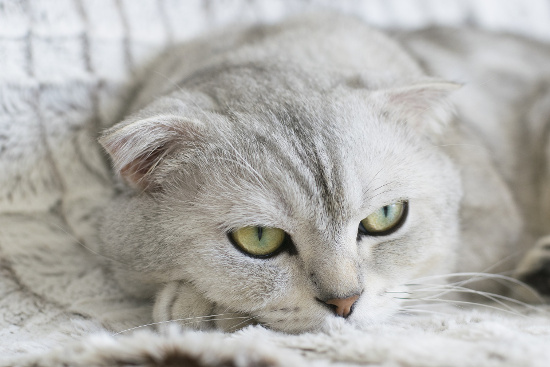
The Ross' were so enchanted and intrigued by the looks and personality of these cats that they started a breeding program (mating with regular domestic and British Shorthair cats) to establish the breed and called them 'lop-eared' or 'lops', as they reminded them of lop-eared rabbits who have long, droopy ears.
Originally the GCCF registered this new breed but, worried about bone abnormalities and possible ear/hearing issues, they stopped registering them in 1971.
Luckily for these gentle and beautiful cats, US breeders took up their cause.
Some of Susies' direct descendents were exported to the US and by the late 1970's vigorous breeding programs involving these cats and both British and American Shorthairs were being established in North America.
In May 1977 the Scottish Fold breed was provisionally recognized by the Cat Fanciers Association (CFA) in the US.
Scottish Fold Cats - appearance & personality
This breed has a sweet, wide-eyed expression in a rounded head, a short neck and a sturdy, compact or 'rounded' (almost chubby) body.
This makes them almost irresistibly adorable, and they retain this kitten-like cuteness even when adults.
Scottish Folds generally weigh somewhere between 6 and 13 lbs when fully grown, with the females being on the lighter end, and the males on the heavier end, of this scale.
The ears may be folded (and the 'degree' of fold can vary from a looser 'single' fold to a tight 'triple' fold), or straight.
This folding is due to a genetic mutation that affects the cartilage in their bodies.
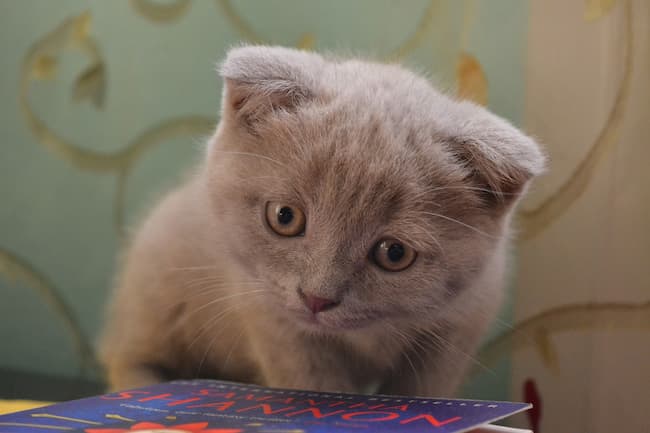
Scottish Fold kittens are all born with straight ears, but by the time they are around 3 to 4 weeks old their ears may begin to show signs of folding.
About 50% of kittens will have ears that fold.
The tips of the ears are always rounded.
The tail should be long and flexible, and a tapered (rather than rounded) tip is preferred.
Scottish Folds can have either short or long coats, and the short fur should be dense.
The longer coats should be full, with a 'ruff' around the neck and a full tail.
They come in a wide variety of colors (can vary slightly depending on the coat length) including......
- Solid colors - including the original pure white, black, blue, red and cream.
- 'Shaded' or 'Smoked' colors - (paler undercoat and dark 'tipping' on outer coat). Including Silver, Gold, Chinchilla, Cameo, Black and Blue.
- Tabby - including red, brown, silver and blue tabby plus mackerel, spotted, ticked, patched and a variety of other tabby colors/patterns.
- Tortoishell
- Calico
- Blue-Cream
- Bi-color - white with unbrindled patches of black, blue, red or cream.
- There are also other acceptable colors/patterns, but 'hybrid' colors such as Lavendar, Chocolate or colored 'points' (such as seen in the Himalyan, Persian or Siamese breeds).
The color of the eyes and nose/paw leather also varies and should correspond to the dominant color of the coat.
Odd colored eyes (one blue and one gold) are allowed in the bi-color and van varieties.
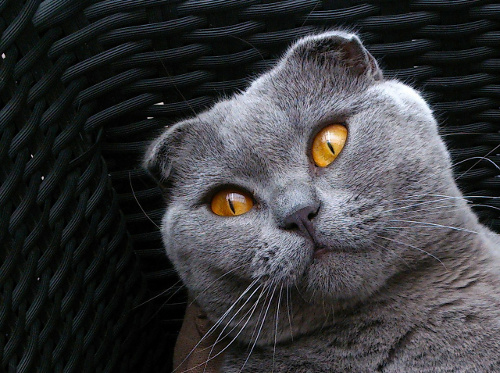 What a cutie!
What a cutie!This cat breed is the 'whole package' and has the personality to match it's adorably 'cuddly' exterior!
Here is a quick summary of the nature of Scottish Folds:
- Affectionate, loving and loyal - but not 'clingy'
- Not given to loud vocal displays
- Tend to be 'one-person' cats and bond closely with their owners
- Adaptable and easy going, good with children and other pets
- Mid-range in terms of activity level
- Intelligent - like to play games/puzzles
- Can be a little 'needy' and don't like being alone for long periods
- Sometimes a little 'stubborn' and (like all cats) have a mind of their own!
One other funny little 'quirk' that is unique to Scottish Fold Cats, is their strange ability to sit upright, on their butt with their back legs straight out, sort of like an otter, or even a furry little Buddah.
It's just too funny!
Scottish Fold Cats - health issues
As with all purebred animals, there are certain health issues that are common to Scottish Folds.
The genetic mutation that gives these cats their adorable folded ears affects the cartilage in their whole body and may also be linked to skeletal problems and deformities.
These might include an unusually short, thick and/or stiff tail, and as 'thickened' or stiff paws or 'fused' leg joints.
This condition is called congenital osteodystrophy and is most often seen when two cats with the 'folded' ears are bred together.
A cat who carries one gene for the folded ear is referred to as being 'fd' and will have straight ears.
If it carries two genes for this trait it's an 'Fd' and will have folded ears.
That's why responsible breeders only breed Folded to Straight pairs, or 'outcross' to American Shorthair and the British Shorthair (the only allowable outcross).
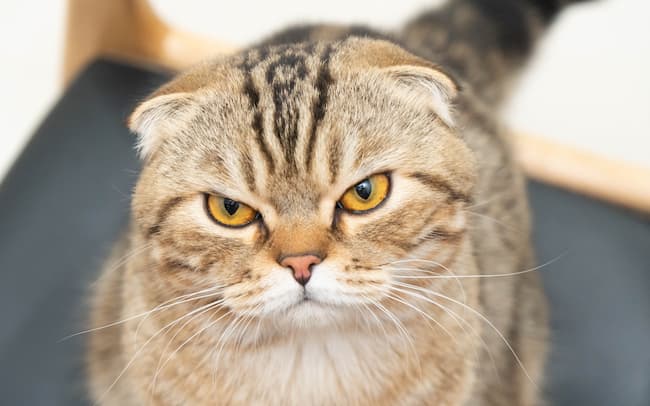
It is possible that those without the genetic folded ears may have an above-average tendency towards developing arthritis in later life, but currently there is not sufficient evidence to say that this is a definite finding.
It is possible that Scottish Fold cats with tightly folded ears may have more problems with ear mites or ear infections so it's a good idea to take a look inside their ears now and then to make sure there's nothing 'brewing'.
Two other fairly major health issues that Scottish Fold cats can suffer from are Polycystic Kidney Disease (PKD) and Hypertrophic Cardiomyopathy (FHC)
When you're thinking about buying a Scottish Fold kitten it's a good idea to make sure the parents have been tested for both of these diseases and are free of them.
Overall careful breeding practices have given this adorable cat a new lease on life and Scottish Folds are now a generally healthy and vigorous breed.
Which is actually very appropriate, given that their very first ancestor was a robust Scottish farm cat!
Related Pages:
- Home
- Scottish Fold Cat


